|
For the epigraphy conference held in Munich next week, I am working on several samples of lettering in goldwork embroidery. More information on the conference can be found in part I of this series. Today we will look at the goldwork lettering on the Vic cope made in England between AD 1350-75. The cope was probably made for, but certainly worn by, Bishop Ramon de Bellera of Vic in Spain. It is all worked in underside couching, typical of Opus Anglicanum. When looking for online information on this particular cope, I found the excellent website of the Museu Episcopal de Vic. The website is in English and there is an abundance of information on their textile collection. Amongst which is a lovely video on the Vic cope (see below). This was my first foray into underside couching and I am going to share my explorations with you below. Unfortunately, my stash did not contain a piece of silk velvet, so I opted for red silk with a twill weave. The original underside couching on the Vic cope is done on three layers of fabric: linen, velvet and plain silk. After the embroidery was finished, the plain silk was carefully cut away. My reconstruction omits the layer of velvet. Although the article (see below for a link to the download) on the recent conservation of the cope mentions a lot of details on the materials used, it does not disclose the width of the gold threads used. However, the pictures in the literature suggest a very fine thread. I decided to go with Stech vergoldet 50/60 CS, which is finer than smooth passing #3. It has a width of 0.12 mm. I started by transferring the lettering of the word 'Epiphania' by using the prick and pounce method. This is the original method for pattern transfer and it would probably have been used by the makers of the Vic cope in the 14th century. I deliberately left my Siena water paint a little thick so that I could scrape off mistakes easily. From the pictures, I could tell that the gold threads were actually couched down in pairs. The couching pattern used for the lettering is the traditional basket weave. I would start with a long stretch down the length of the letter and use the twill pattern of the silk to get my spacing correct between the couching stitches. I found this not too easy as you'll need a rather large needle for the linen couching thread. For the first four letters ('epip') I used Fil de lin glace, au Chinois, #40 colour #363 (yellow), which I bought at Maison Sajou when I was in Paris. It is rather thick and not very strong. Even when I changed from a needle #7 to a chenille needle #22, it broke frequently. No matter how carefully I tried to guide the thread through the fabrics. What else could I use? First up was Londonderry linen thread #5070 cornflower 50/3. It is only slightly thinner than the Maison Sajou thread used before. On stitching the 'H', the thread broke three times. This is far less than when I used the Maison Sajou thread. One other thing that eludes me at the moment: what does one do with the tails of the goldthreads? After consulting with a re-enactment lady on Instagram, she said she plunges them and ties them back with the linen couching thread. Sounds reasonable, don't you think? Except for the fact that the stitches on the back are rock solid and I can't weave any thread tails through them at all. Maybe I should use a finer linen thread? Next up was Goldschild 50/3. Although the numbers suggest the thread is comparable in thickness to the Londonderry, it is actually less thick. It did break easily, especially on the small bar-like parts of the 'A'. These parts are really tricky to do as you can't keep the basket weave pattern going. You'll end up with a kind of underside couching satin stitch. The quick turns for both the gold threads and the linen couching threads take their toll. I had one more brand of linen threads I could test: Bockens Knyppelgarn. I started with the rather thin Nel 90/2 and this was no good as it broke every other stitch. But when I tried the thicker Nel 35/2, it was much better. A similar amount of breaks to the Londonderry thread. But again, I am unable to tie back the goldthreads with the linen couching thread on the back. Since I know that medieval stitchers were not averse to using knots, I did the same. Works a treat. So what did I learn from this experiment? Quite a lot actually! Firstly, turning your threads at the design line is done with an underside couching stitch. There is no additional 'normal' couching stitch on top to achieve this. Secondly, underside couching is a bit like constantly plunging. No matter how drum taut your slate frame is, it will lose a bit of tension. Thirdly: my silk did not take the stitching very well. Fibres of the weft were pulled out. Fourth: the stitching is rather harsh on your body. My fingers are all swollen and my back aches (muscle ache). How the flip did they do it back then? They worked through three layers of fabric. That puts even more strain on your body and on the linen threads. I must have some of the parameters wrong. Suggestions are greatly appreciated! Literature
Brow, C, G. Davies & M.A. Michael (eds.), 2016. English medieval embroidery. Yale University Press. ISBN: 978-0-300-22200-5. Calonder, N. & A. Wos-Jucker, 2008. Conservation of the Cope of Bishop Ramon de Bellera, Quaderns del Museu Episcopal de Vic 2, pp. 83-99. Grimm, J.M., 2021. A hands-on approach - Epigraphy in medieval textile art, in: Kohwagner-Nikolai, T., Päffgen, B., Steininger, C. (Eds.), Über Stoff und Stein. Knotenpunkte von Textilkunst und Epigraphik. Harrassowitz, Wiesbaden, pp. 141–147. P.S. Did you like this blog article? Did you learn something new? When yes, then please consider making a small donation. Visiting museums and doing research inevitably costs money. Supporting me and my research is much appreciated ❤!
5 Comments
Last week, I and my husband visited the exhibition "L'art en broderie au moyen age" at the Musee Cluny in Paris. The exhibition draws together medieval embroidery from the museum's own collection and from other collections in Europe. Private textile collections from the 19th century (such as the one from Franz Bock) got split up at some point and fragments of the same piece would end up in the Victoria & Albert Museum in London and the Musee Cluny in Paris. It was great to see some happy reunions! I encountered many new to me pieces as well as some 'old friends'. The exhibition was very popular with a wide range of visitors. And there was so much on display that we actually visited twice. Hence, I can't cover it all in one blog post. Today we'll look at the masterpieces from the Germanic lands and the Mosan region (the old Bishopric of Liege). These pieces are characterised by a Romanesque style which still contains many elements of classical art. They have an older feel to them. In addition, these pieces are often completely stitched in coloured silks on linen. One of my favourite pieces of the whole exhibition was the altar cloth or antependium from Mechelen (now part of Belgium). The piece measures 82,5 x 186,5 cm and was made in the early 14th century. The piece depicts four scenes from the Saints lives: Saint Martin healing the infirm, Saint Mark being persecuted during Easter Mass, Saint John sleeping on Christ's lap and Saint John drinking poison in front of Aristodemus of Ephesus. The whole piece consists of counted needlepoint in silks and some gold on a linen background. The different parts of the design are filled with a myriad of counted needlepoint stitches made up of satin stitches. The stitches used for the background give it an embossed appearance. Look at the picture of the face of Saint Mark to see the fineness and the quality of the linen background used for this stunning piece of embroidery. Another stunning piece is this frieze for an antependium made AD 1320-1330 in either the Mosan region or greater Paris. This piece was very hard to photograph due to the way it was displayed. The piece shows scenes from the life of Saint Martin of Tours. You can see him in the second picture sitting on his horse and cutting his mantle in half. The piece is only 19 cm high, but a staggering 256 cm long! The embroidery uses coloured silks and both gold and silver threads. Where the embroidery has worn away, the pattern drawing and the linen padding can be clearly seen. I especially like the treatment of the hair of the figures: very textured with a lot of tiny knots. The third and last piece I like to draw your attention to is a beautiful alms pouch. It is made in the same counted needlepoint technique with silks and gold threads as seen on the antependium from Mechelen. The shine on the silken stitches is unbelievable! This particular purse was made around AD 1300 in either the Mosan region or the Germanic lands. As medieval clothing came without pockets, people wore purses like these to store their money and other belongings such as prayer beads, a book of hours etc. The name 'alms pouch/purse' refers to the common practice of giving alms to the poor as part of your everyday Christian duty. You can find an excellent article on these purses here.
There were many more beautiful pieces on display in this part of the exhibition. For those of you who were not able to visit in person, I can highly recommend the exhibition catalogue. It is packed full with good quality pictures and many close-ups. More on my textile adventures in Paris in further blog posts! Literature Descatoire, C., 2019. L'art en broderie au moyen age. Musee de Cluny. ISBN: 978-2-7118-7428-6. Müller-Christensen, S. & M. Schuette, 1963. Das Stickereiwerk. Wasmuth. No ISBN. Wilckens, L. von, 1991. Die textilen Künste von der Spätantike bis um 1500. Beck. ISBN 3-406-35363-0. P.S. Did you like this blog article? Did you learn something new? When yes, then please consider making a small donation. Visiting museums and doing research inevitably costs money. Supporting me and my research is much appreciated ❤! Happy New Year to you all! My 2020 started with a 630 km round-trip to Bamberg. The diocesan museum houses some of the finest medieval goldwork embroideries in Europe. These exquisite pieces are a staggering 1000-years old! I was able to take some good pictures, which I am going to share with you here. Unfortunately, there was virtually no information available in the museum so I can't really tell you much about the pieces. However, I've ordered some literature and will do a further post with those details when the papers arrive. Probably the most famous piece held at the museum is the so-called "Sternenmantel Kaiser Heinrich II des Heiligen" (star mantle of Saint emperor Henry II). It was used as a cope or pluviale and measures 297 cm by 154 cm. The mantle shows Christological depictions, astrological signs and 14 roundels with busts of saints and many Latin inscriptions explaining what is depicted. Unfortunately, the gold embroidery was re-applied to the blue Italian silk damask we see today in 1503. The original design got mixed up and not all writing makes sense. Some scholars argue that in fact two mantles were made into one. The original background fabric was a dark-purple silk samite. Traces can still be seen on the inside of the different design elements. When the pieces were transferred onto the new blue damask, the edges were covered with a thick white strand of silk couched down with a thinner strand of white silk. To have an even better attachment, some of the design lines on the inside were covered with split or chain stitches using red silk. The original gold embroidery uses VERY fine passing thread and white, red, blue and green silk for the couching stitches. It looked to me that the passing thread has been couched as a single thread, rather than in pairs. Traditionally, this mantle is dated to AD 1010-1020 and its place of origin as Regensburg with a ?. The mantle is seen, based on the embroidered inscriptions, as a gift from Melus of Bari (died 1020 in Bamberg) when he sought the support of Emperor Henry II for his revolt against the Byzantine Empire. It is, therefore, more logical that the mantle was made in Southern Italy. The second famous mantle held at the diocesan museum in Bamberg is that of Saint Kunigunde, wife of emperor Henry II. This cope measures 286 cm by 162,5 cm and shows biblical scenes, a.o. related to Christ saviour and to the lives of the patrons of Bamberg Cathedral: St. Peter and St. Paul. Lettering around each roundel explains the stitched scenes. This cope was likely a donation by empress Kunigunde to the cathedral and made around 1020 AD in Southern Germany. The original VERY fine goldwork embroidery was stitched on a background of blue silk twill. There are 56 parallel passing threads per centimetre (!!!) and this means that each passing thread (a strip of gold foil spun around a silk core, see my previous blog on the manufacture of gold threads) had a width of about 0.18 mm. In comparison: my finest passing thread (Stech 50/60 CS) has a width of 0.22 mm. Pretty mindblowing, don't you think?! For the figures, these parallel passing threads lay vertically and are couched down in several different patterns using white, red, light- and dark blue silks. Further details are stitched in stem stitch. The embroideries from this mantle have also been re-applied onto a new fabric in the 16th century. Why have these two pieces survived in such splendid condition? This is due to the fact that both copes or mantles were related to the emperor and his empress. Both were sanctified. Bamberg employed these famous saints for their own marketing purposes since the late Middle Ages. This is likely the reason why the pieces were re-applied and probably altered then. Quasi to strengthen the case of the link between Bamberg and these two saints. Currently, a four-year research project on these vestments runs until 30-09-2020. For the first time, the art historians are employing scientific techniques to determine the origins of the materials used in these exquisite goldwork embroideries. We can thus look forward to a volume of papers being published on the subject in the coming years! Literature Enzensberger, H., 2007. Bamberg und Apulien, in: Das Bistum Bamberg in der Welt des Mittelalters (=Bamberger interdisziplinäre Mittelalterstudien. Vorträge und Vorlesungen 1), C. & K. van Eickels (eds), p. 141–150. Kohwagner-Nikolai, T., 2014. O Decus Europae Cesar Heinrice? Die Saumumschrift des sogenannten Bamberger Sternenmantels Kaiser Heinrichs II, Archiv für Diplomatik, Schriftgeschichte, Siegel- und Wappenkunde 60/1, p. 135–164. Schuette, M. & Müller-Christensen, S., 1963. Das Stickereiwerk. Wasmuth. No ISBN. P.S. Did you like this blog article? Did you learn something new? When yes, then please consider making a small donation. Visiting museums and doing research inevitably costs money. Supporting me and my research is much appreciated ❤!
|
Want to keep up with my embroidery adventures? Sign up for my weekly Newsletter to get notified of new blogs, courses and workshops!
Liked my blog? Please consider making a donation or becoming a Patron so that I can keep up the good work and my blog ad-free!
Categories
All
Archives
April 2024
|
Contact: info(at)jessicagrimm.com
Copyright Dr Jessica M. Grimm - Mandlweg 3, 82488 Ettal, Deutschland - +49(0)8822 2782219 (Monday, Tuesday, Friday & Saturday 9.00-17.00 CET)
Impressum - Legal Notice - Datenschutzerklärung - Privacy Policy - Webshop ABG - Widerrufsrecht - Disclaimer
Copyright Dr Jessica M. Grimm - Mandlweg 3, 82488 Ettal, Deutschland - +49(0)8822 2782219 (Monday, Tuesday, Friday & Saturday 9.00-17.00 CET)
Impressum - Legal Notice - Datenschutzerklärung - Privacy Policy - Webshop ABG - Widerrufsrecht - Disclaimer

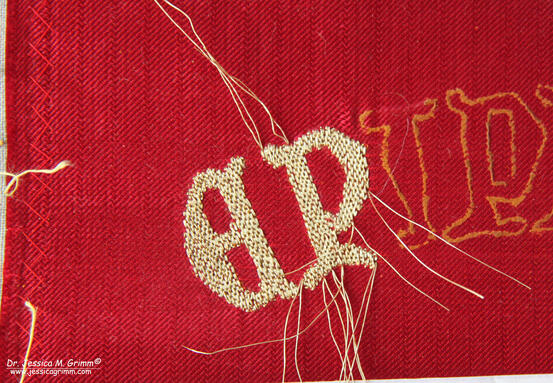
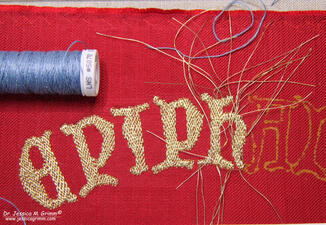
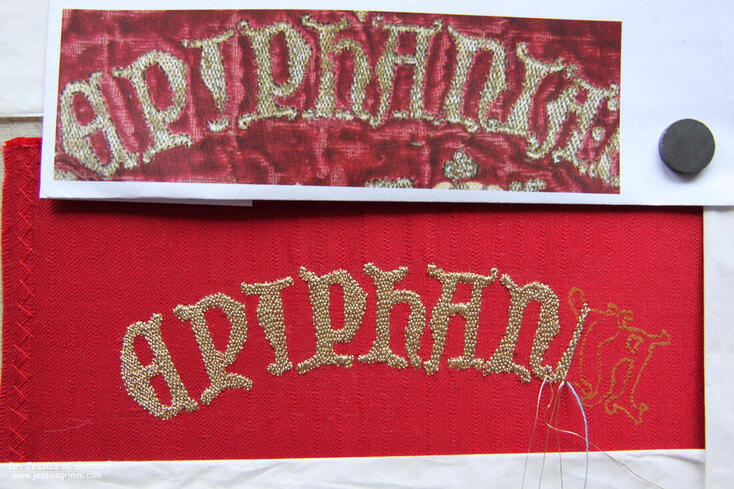
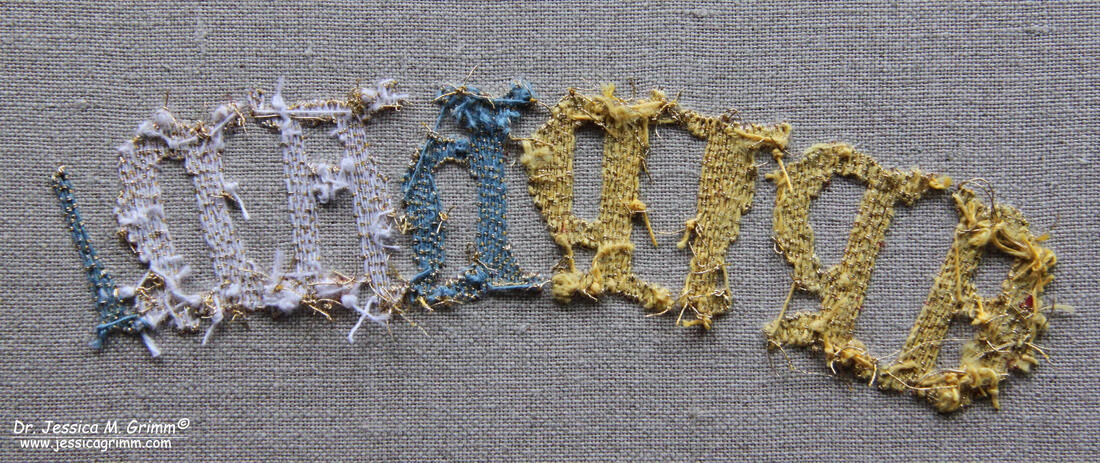
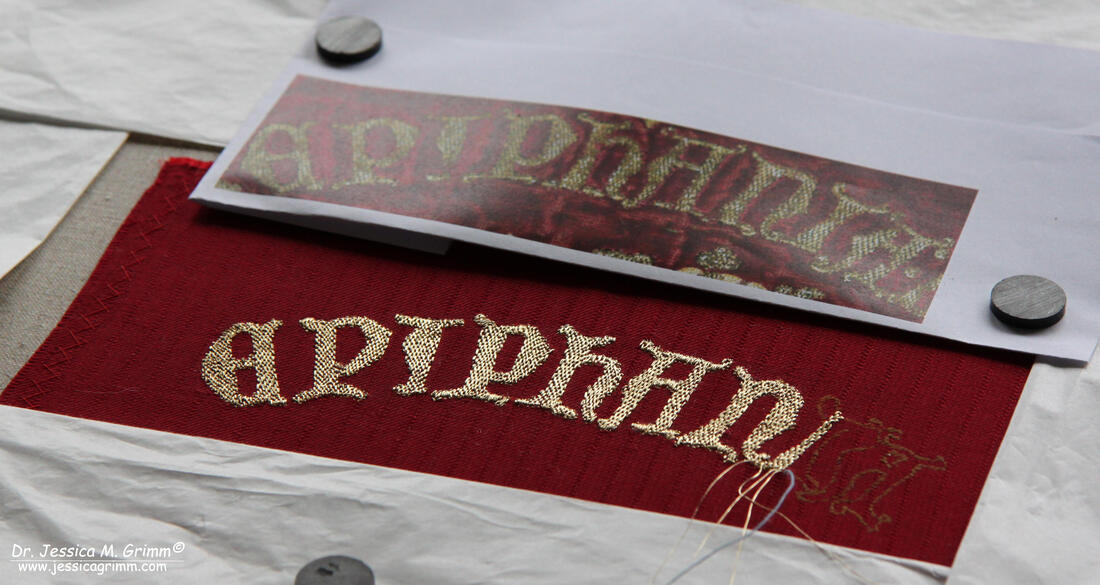
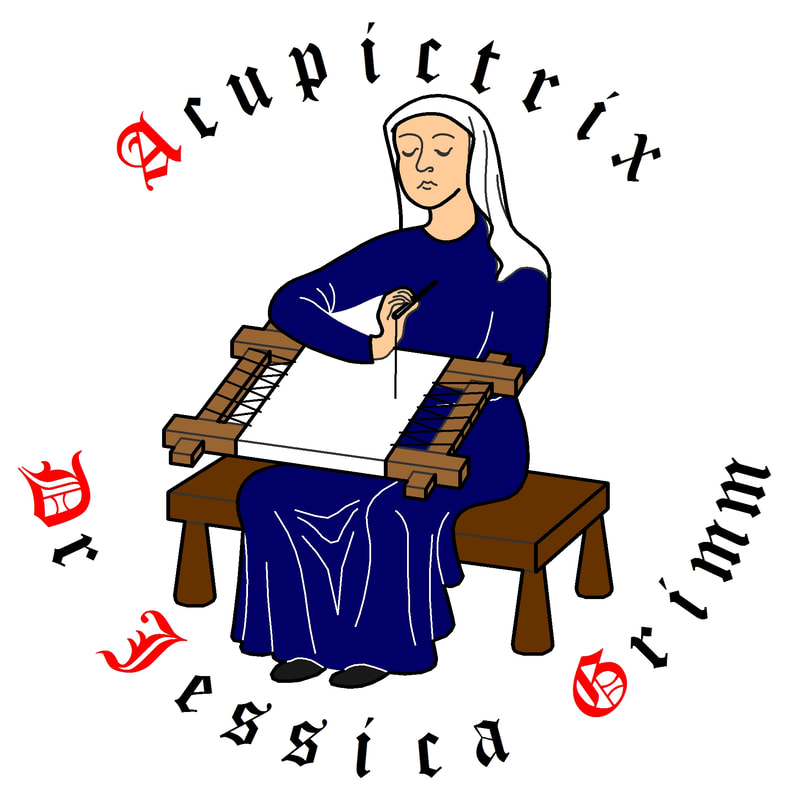

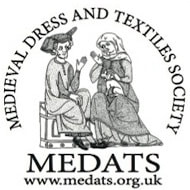
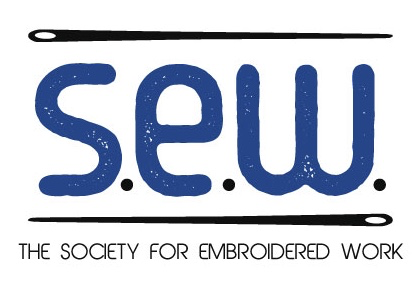
 RSS Feed
RSS Feed